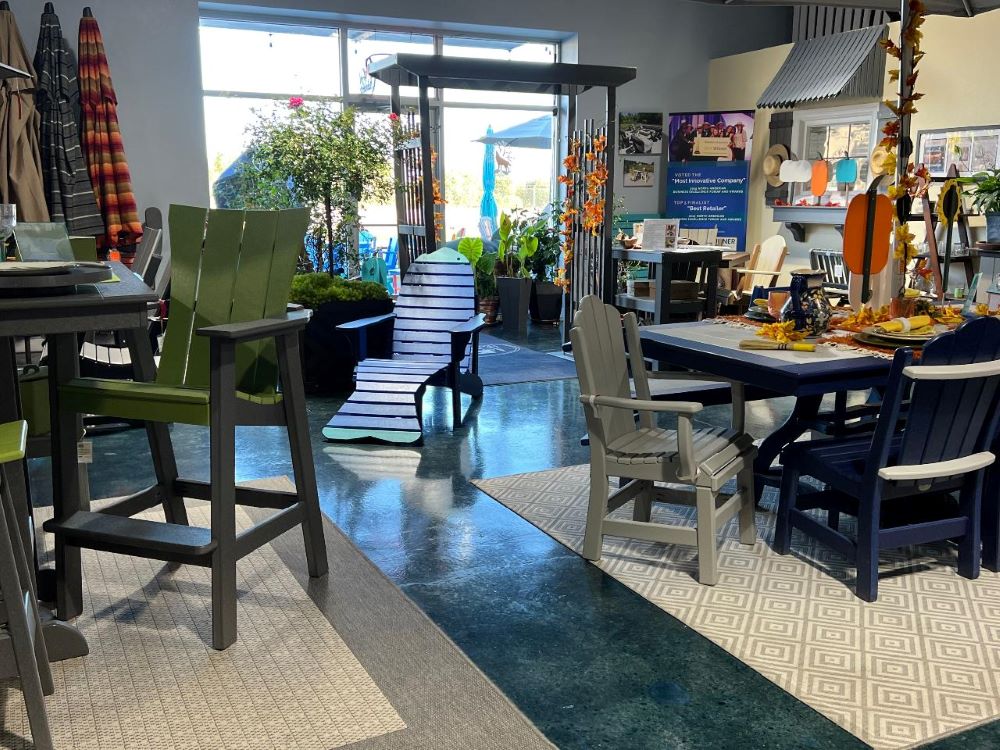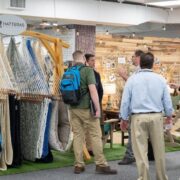At Amish Craftsmen Guild II in Cedarburg, Wisconsin, sometimes it’s luck, sometimes it’s skill and sometimes, it’s both.
Laura Armstrong-Goss, president and CEO of the outdoor retailer, has found a way to combine the best traditions of Old Order Amish craftsmanship with today’s building material, poly lumber, partly because of an allergic reaction.
She tells it this way: More than 25 years ago, the company started out selling rustic Amish furniture made of hardwoods by crafters in the Pennsylvania community where she grew up.
“We did only shows and farmers markets and we had one Chicagoland account given to me from my brother who founded and opened a store in High Point, North Carolina,” says Armstrong-Goss. “Being that I lived in Wisconsin and was traveling back and forth to Pennsylvania, he asked me if I would use my camper van to drop off some furniture in Chicagoland. Shortly thereafter, he asked if I was interested in taking over that account as it was too far away for him to service and provide product.”
She said that her eldest daughter was preparing to leave for college and she knew the money would come in handy, so she agreed.
Not long after that, one of the crafters developed a sensitivity to the wood finishes, while almost simultaneously, Armstrong-Goss discovered poly lumber, which is made from high-density polyethylene, which that particular crafter could use.

“We then pioneered together with the Amish crafters, as we innovated and collaborated with several different crafters and developed a niche market of sustainable outdoor casual furniture made of poly lumber, starting in 1999,” says Armstrong-Goss. “We have moved forward ever since. What a labor of love and a fun run it’s been watching a whole industry open up and evolve due to finding a way and saying yes to the opportunities serendipity provided.”
These days, Armstrong-Goss says, her days are spent getting ready.
“I am excited to be preparing the best growth and environment for our next generation to move into the roles my husband and I have been growing into for the last few decades,” she says. “There is a bright and promising future despite what is seen on our everyday social media feeds. Life is an exciting adventure to be embraced and lived well. I am excited to still be part of it and influencing a better tomorrow for all.”
Right now, she says, the most important thing for retailers to do is to focus on the human touch, to identify and respond quickly to the needs of the customer, and to know and listen to your client.
Merchandising, product assortment and lead times “are all important factors,” she says. “Some will make more of a difference to each customer, depending on their needs and desires.”

What is concerning is the possibility of a slowdown in sales.
“There may or may not be (a slowdown) based on many factors and unknowns,” says Armstrong-Goss. “Some we will have control over and others we may not. Those we don’t have control over, we will have to use what we learned in the last few years regarding making decisions on pivoting, staying positive and hopeful, and acting with confidence and trust for the best.”
She says that a big challenge for her has been that the store has been short-staffed, which Armstrong-Goss has responded to in creative ways.
We have focused on team-building through adjusting our hours seasonally, and we have added high school teammates, when possible, working around their academic and athletic schedules and adjusting roles and responsibilities of our part-time and full-time workers.
In some cases, Armstrong-Goss has improved productivity by showing certain employees to the door.
“Productivity has been a focus and releasing whiners or complainers to the larger workforce has been a great move,” she says. “Not having negative energy spin in a downward spiral has been a relief and allowed the outward and upward spin draw in a happier and more flexible team, resulting in a more positive environment the whole way around.”
The decision on which manufacturers to carry? That one’s easy.
“Since my brother and I were the original pioneers that introduced poly lumber to the Amish community, we have innovated and collaborated unique and shared designs with crafter builders since day one,” says Armstrong-Goss. “This has allowed us to have our own line, some of it built exclusively for our company and some which we share. We have been fortunate that this has served us well to this point.
To market, Armstrong-Goss says it’s crucial to get the first sale.
“We estimate that 60% of our customers are return and referral,” she said. “We have done custom orders since day one and also used a small variety of other marketing avenues including trade shows. We will continue what we are currently doing and continue to become better at it daily.
That will include better employee training and continuing to focus on customer service.
Armstrong-Goss says the increase in full-line retailers has possibly affected the business, particularly if her store has not done a good job of communicating and building relationships.
“Competition allows us to keep our pencils sharp, so to say,” she says. “It depends upon the environment we are in and creating for our customers and for our team to work in. Having a small but high-end family business with dedicated teammates focused on excellence, innovation and creativity has allowed us continuous growth.
“Hopefully, this attitude and commitment to excellence and customer care will continue to allow us to grow into the next generations as technology changes my team will continue to grow with it.”
Any advice for struggling casual retailers?
“Be and present your best self while serving the needs of your teammates, customers and your community with honesty, integrity and excellence,” says Armstrong-Goss. “This will ultimately allow you to serve yourself and your family needs. Know your customer and their needs. Understand that it is not everyone who walks through your doors all the time that you can help every time. May you know your opportunities, possibilities and your limitations.”








